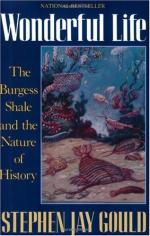
|
| Name: _________________________ | Period: ___________________ |
This test consists of 15 multiple choice questions and 5 short answer questions.
Multiple Choice Questions
1. What is one of the first tasks of the paleontologist after producing a clear specimen?
(a) Classify the specimen in taxonomy.
(b) Categorize each file according to specimen.
(c) Write a monograph on observation alone.
(d) Naturalize the environment and take samples.
2. Who newly interpreted the Burgess animals in 1971?
(a) Dr. Whittington of Yale and her husband.
(b) Dr. John Whit and his colleagues.
(c) Professor Matt Stephens and his wife.
(d) Professor Harry Whittington of Cambridge and his colleagues.
3. What was Opabinia's frontal nozzle not?
(a) A carapace.
(b) Part of its head.
(c) A proboscis.
(d) A second mouth.
4. What does the Precambrian Era contain?
(a) Physical, non-linear time and the advent of multi-cellular life.
(b) Rational, linear logic and the advent of single-celled life.
(c) Spatial, non-biological time and the decimation of single-celled life.
(d) Geological, non-biological time and the advent of single-celled life.
5. What types did Whittingdon use to classify the new species?
(a) Cilial types.
(b) Regenerative types.
(c) Mollusk types.
(d) Arthropod types.
6. How does Gould begin Chapter 2: "A Background for the Burgess Shale"?
(a) Explaining what the Burgess Shale represents.
(b) Explaining how scientists divide up historical epochs.
(c) Explaining the last chapter's conclusion.
(d) Explaining which animals are in the Burgess Shale.
7. What comprises the first 4 billion years of Earth's history?
(a) The Mesozoic Era.
(b) The Precambrian Era.
(c) The Cambrian Era.
(d) The Prestige Era.
8. After publishing his first monograph, which two graduate students did Whittington employ?
(a) Briggs Morris and Simon Conway.
(b) Barry Moser and Simeon Martin.
(c) Jeremy Morris and Derek Briggs.
(d) Simon Conway Morris and Derek Briggs.
9. What cost comes with accepting Gould's picture of human evolution?
(a) Compensatory cost.
(b) Psychological cost.
(c) Physical cost.
(d) Monetary cost.
10. What pushed Whittington beyond the idea he struggled under?
(a) Wiwaxia.
(b) Opabinia.
(c) Yohoia.
(d) Marella.
11. What did Marrella and Yohoia still appear to be?
(a) Unknown creatures.
(b) Crustaceans.
(c) Vertebrates.
(d) Arthropods.
12. What is the most common organism among the Burgess Shale fossils?
(a) Signi marella.
(b) Titilla splendens.
(c) Sanctocaris.
(d) Marrella splendens.
13. What does the Burgess Shale represent that occurred 570 million years ago?
(a) The "Cambrian Explosion."
(b) The "Prezoaic Explosion."
(c) The "Anthropological Explosion."
(d) The "Precambrian Explosion."
14. What did the new methods Whittington and his team adopted help them do?
(a) Transport the fossils.
(b) Organize the fossils.
(c) Study the fossils.
(d) Recast the fossils.
15. When did Whittington begin studying Opabinia?
(a) 1975.
(b) 1890.
(c) 1980.
(d) 1978.
Short Answer Questions
1. What does Gould represent the original interpretation as?
2. Who discovered Harry Whittington's analysis of fauna decades later?
3. How many years did Whittington spend on his 1979 monograph?
4. When was the famed "death of the dinosaurs?"
5. What is the Burgess Shale?
|
This section contains 470 words (approx. 2 pages at 300 words per page) |

|




